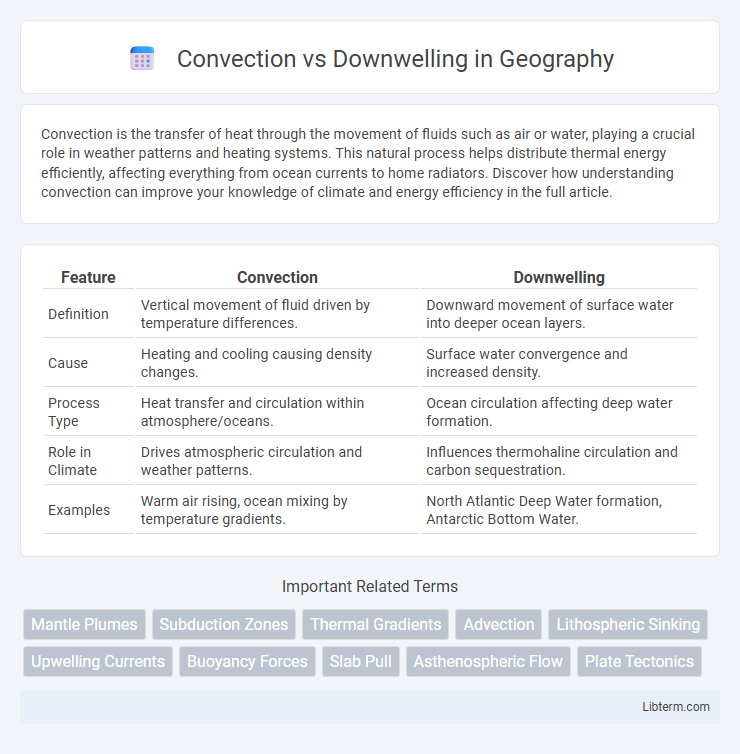Convection is the transfer of heat through the movement of fluids such as air or water, playing a crucial role in weather patterns and heating systems. This natural process helps distribute thermal energy efficiently, affecting everything from ocean currents to home radiators. Discover how understanding convection can improve your knowledge of climate and energy efficiency in the full article.
Table of Comparison
| Feature | Convection | Downwelling |
|---|---|---|
| Definition | Vertical movement of fluid driven by temperature differences. | Downward movement of surface water into deeper ocean layers. |
| Cause | Heating and cooling causing density changes. | Surface water convergence and increased density. |
| Process Type | Heat transfer and circulation within atmosphere/oceans. | Ocean circulation affecting deep water formation. |
| Role in Climate | Drives atmospheric circulation and weather patterns. | Influences thermohaline circulation and carbon sequestration. |
| Examples | Warm air rising, ocean mixing by temperature gradients. | North Atlantic Deep Water formation, Antarctic Bottom Water. |
Introduction to Convection and Downwelling
Convection refers to the process where warm, less dense fluid rises while cooler, denser fluid sinks, creating a circulation pattern that transfers heat within Earth's atmosphere or oceans. Downwelling occurs when surface water converges and sinks, often transporting oxygen-rich water to deeper layers, crucial for marine ecosystems. These dynamic processes influence climate patterns, ocean circulation, and nutrient distribution.
Defining Convection in Geosciences
Convection in geosciences refers to the process of heat transfer through the movement of fluid or molten material within the Earth's mantle, driven by temperature and density differences. This dynamic mechanism facilitates the circulation of magma and influences plate tectonics by causing hot, less dense material to rise while cooler, denser material sinks. Downwelling is the complementary process where cooler, denser material descends, contributing to the mantle convection cycle that shapes geological phenomena such as volcanic activity and seafloor spreading.
Understanding Downwelling Processes
Downwelling occurs when surface waters converge, causing denser water to sink and transport oxygen and nutrients to deeper ocean layers, which supports marine life at depth. This process plays a crucial role in regulating global climate by sequestering carbon dioxide and distributing heat throughout the ocean. Understanding downwelling dynamics helps scientists predict ocean circulation patterns and their impact on weather systems and marine ecosystems.
Key Differences Between Convection and Downwelling
Convection involves the vertical movement of fluid caused by temperature-induced density differences, where warmer, less dense fluid rises and cooler, denser fluid sinks, driving heat transfer. Downwelling refers specifically to the sinking of surface water into deeper ocean layers, typically due to increased water density from cooling or salinity changes, impacting ocean circulation and heat distribution. While convection is a general fluid dynamics process, downwelling is a specific oceanographic phenomenon crucial for nutrient cycling and climate regulation.
Mechanisms Driving Convection
Convection in oceans is driven by temperature and salinity differences causing density variations that lead to vertical water movement. Downwelling occurs when surface waters become denser through cooling or increased salinity, forcing surface water to sink and displace deeper water. These mechanisms play crucial roles in thermohaline circulation and nutrient transport within marine ecosystems.
Causes and Effects of Downwelling
Downwelling occurs when surface waters converge and sink, driven by wind patterns and differences in water density influenced by temperature and salinity. This process transports oxygen-rich surface water to deeper ocean layers, supporting marine ecosystems and influencing nutrient distribution. Downwelling also plays a critical role in regulating global climate by aiding the sequestration of carbon dioxide from the atmosphere into the deep ocean.
Atmospheric and Oceanic Examples
Convection in the atmosphere drives the upward movement of warm air masses, forming clouds and storm systems, while downwelling occurs when cooler, denser air descends, leading to high-pressure zones and clear skies. In oceanic contexts, convection causes warm surface waters to rise and mix with cooler layers, promoting nutrient cycling and heat distribution, whereas downwelling involves surface waters sinking, crucial for transporting oxygen to deep ocean ecosystems. These processes significantly influence global climate patterns, including the formation of trade winds and deep ocean currents such as the thermohaline circulation.
Convection vs Downwelling in Earth’s Mantle
Convection in Earth's mantle involves the upward movement of hot, buoyant material from deeper regions, while downwelling describes the sinking of cooler, denser lithospheric plates back into the mantle. These processes drive plate tectonics and mantle circulation, influencing volcanic activity and earthquake distribution. Mantle convection cells and downwelling zones facilitate heat transfer from Earth's interior, maintaining the planet's thermal and dynamic equilibrium.
Environmental Impacts of Both Processes
Convection drives oceanic and atmospheric circulation, redistributing heat and nutrients, which supports marine ecosystems and influences global climate patterns by regulating temperature and weather systems. Downwelling transports oxygen-rich surface waters to deeper ocean layers, sustaining deep-sea life and aiding in carbon sequestration by moving carbon dioxide away from the atmosphere. Both processes play critical roles in maintaining oceanic health, but disruptions due to climate change can alter their intensity, impacting biodiversity, carbon cycles, and climate regulation.
Conclusion: Convection and Downwelling Compared
Convection and downwelling are essential oceanic processes that drive vertical water movement, affecting temperature distribution and nutrient cycling. Convection primarily involves buoyancy-driven flow caused by temperature or salinity differences, leading to upward or downward motion, while downwelling specifically refers to the sinking of surface water into deeper layers, often near coasts or converging currents. Both contribute to global thermohaline circulation but differ in their triggers and spatial impact on marine ecosystems.
Convection Infographic

 libterm.com
libterm.com